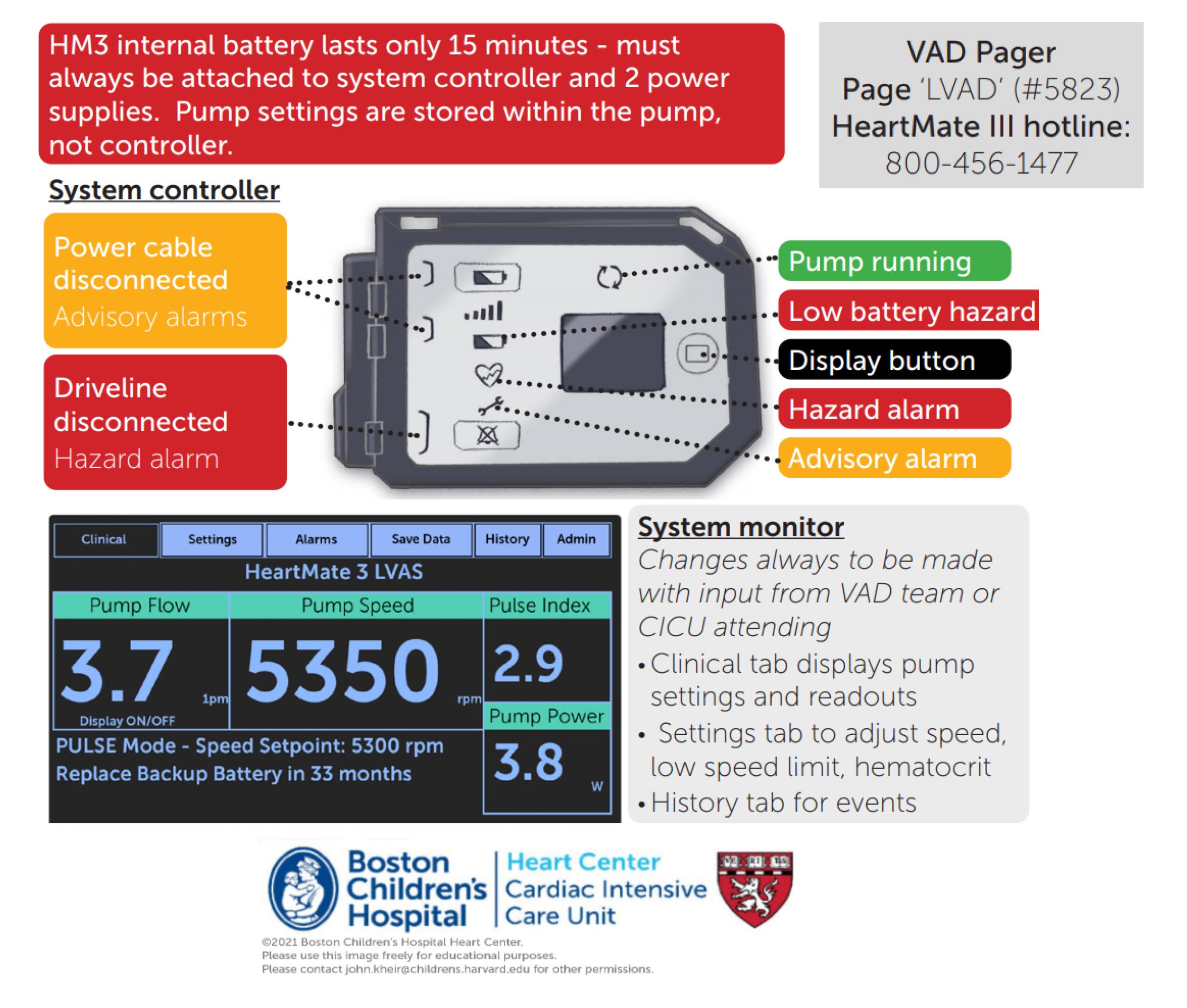The HeartMate III flow device is placed into the LV or RV apex. Magnetic levetation maintains a thin layer of blood between impeller and pump housing, avoiding mechanical contact (preventing hemolysis). Blood is drawn into device along central axis and expelled at right. A key feature of HeartMate III is the pulsatility mode, a setting that varies pump speed to ‘wash’ the pump and prevent areas of stasis and thrombosis.

Continuous flow device placed into the LV apex. Magnetic levetation maintains a thin layer of blood between impeller and pump housing, avoiding mechanical contact (preventing hemolysis). Blood is drawn into device along central axis and expelled at right. A key feature of HeartMate III is the pulsatility mode, a setting that varies pump speed to ‘wash’ the pump and prevent areas of stasis and thrombosis.
Hazard Alarms (Heart)
VAD stopped –> Check Driveline (verify no yellow is showing on connection)
• VAD stopped –> Change Controller (must also attach power to work) • Critical Battery (1 or 2) –> Change appropriate battery
• Controller Failed –> Change Controller
Advisory Alarms (Wrench)
• Controller fault, high watts, electrical fault, low flow, suction –> Call CICU and VAD attending • Low Battery (1 or 2) –> Change appropriate battery
• Power Disconnect (1 or 2) –> Reconnect power sources

- Pulse mode = every 2 seconds, pump speed decreases by 2000 RPM for 0.15 seconds then increases by 4000 RPM for 0.2 seconds, then back to baseline RPM setting.
- Pump speed (RPMs) = rotational speed of centrifugal pump head (usual 4700-6200 RPM; median adult range 5400 RPM). This is the only parameter that is set by the team. Goals include normal cardiac index, no septal shift, intermittent AV opening. Measured pump speed may vary ~50 RPM from set speed due to pulsatility.
- Low speed limit is set 200-400 RPMs below pump speed; pump defaults to this speed during ‘PI’ events.
- Pump power (watts) = power required to achieve rotational speed. This parameter is measured by the device as a reflection of resistance. May increase with afterload, suction events, and thrombus formation. Range 3-6 watts; >10 watts may indicate thrombus.
- Pump flow (L/min) = calculated based on pump speed, pump power and inputted hematocrit. At any pumping speed, increased blood pressure results in decreased flow. Decreased flow may be caused by hypovolemia, hypertension, arrhythmia, inflow obstruction, outflow graft obstruction.
Low flow troubleshooting
- Examine for arrhythmia, hypertension, hematocrit setting, pump speed setting • Low CVP = hypovolemia: consider bleeding, giving volume, holding diuretics
- High CVP with evidence of LV collapse: consider RV failure, atelectasis, tamponade, pulmonary HTN
- High CVP without evidence of LV collapse = hypervolemia: consider increase in pump speed
Resources
VAD Team Homepage
VAD Team HeartMate III Powerpoint
HeartMate III Interdisciplinary Guide